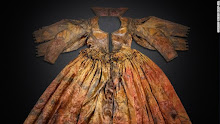In honor of the coronation of King Charles III, looking back at his mother’s ceremonial gown: “The Story Behind Queen Elizabeth II's Dazzling—and Highly Symbolic—Coronation Gown”…an article by Emily Chan for Vogue. [reprinted below]
“One October afternoon in 1952, Her Majesty the Queen desired me to make for her the dress to be worn at her Coronation,” Hartnell recalled in his 1955 autobiography, Silver and Gold. “I can scarcely remember what I murmured in reply. In simple conversational tones, the Queen went on to express her wishes. Her Majesty required that the dress should conform in line to that of her wedding dress and that the material should be white satin.”
Soon afterwards, Hartnell submitted eight designs to fulfill the brief, the first of which was based on Queen Victoria’s coronation gown—a white satin dress with gold embroidery. Other sketches featured the Tudor rose and oak leaves, alongside one design based around the Madonna. Elizabeth opted for the eighth design, which incorporated the national emblems of the United Kingdom: the rose (England), thistle (Scotland), shamrock (Northern Ireland), and daffodil (Wales)—although the latter was changed to the leek, the official national emblem of Wales.
The Queen requested several other modifications to the design, including that the embroidery be done using pastel-colored silks, rather than just silver. Her Majesty also asked for national symbols of Commonwealth countries to be added, including the acacia (Australia), fern (New Zealand), maple leaf (Canada), protea (South Africa), lotus (India), and wheat, cotton, and jute (Pakistan).
The finished coronation gown featured a sweetheart neckline and a delicate lattice design, with the emblems—decorated with seed pearls, sequins, and crystals—separated by heavily embellished scalloped borders comprising gold bugle beads, diamantés, and pearls. Hartnell also included a surprise for Her Majesty: a four-leafed shamrock on the left side of the skirt as a symbol of good luck.
All in all, the coronation dress weighed a hefty 30 pounds, or 13 kilograms, which combined with the Robe of Estate—which was made of deep purple velvet and an ermine trim, and took 3,500 hours to make—and St Edward’s Crown, was quite the weight for Her Majesty to bear. To finish off her historic outfit, the Queen asked French shoemaker Roger Vivier to create a pair of gold pumps featuring a jewel-encrusted heel and fleurs-de-lis pattern on the upper that matched the motif on both St Edward’s Crown and the Imperial State Crown (worn at the end of the ceremony). When it came to her jewelry, Elizabeth wore a dazzling diamond necklace and earrings that were originally made for Queen Victoria.
A long-time repeat wearer, the Queen actually went on to wear the Coronation gown a further six times, including at the opening of parliament in New Zealand and Australia in 1954. It’s an attitude towards fashion that the late monarch has certainly passed down to her son, King Charles III, as he is crowned at Westminster Abbey on Saturday.



.jpg)

















